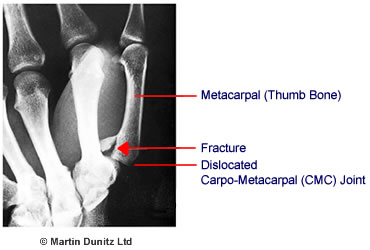Bennett’s Fracture in Depth
AKA: Fracture Dislocation of the Thumb
| Common Signs & Symptoms | |||||
| Pain | Swelling | Stiffness | Weakness | Instability | Locking |
Bennett’s Fracture Injury Explained
Bennett’s fracture is a fracture dislocation of the thumb. A fracture dislocation at the base of the thumb is not uncommon in boxers, rugby players, American football players and football (soccer) goalkeepers. It refers to a fracture of the Metacarpal (thumb) bone at the joint surface with the Carpal (wrist) bones. This joint is called the Carpo-Metacarpal (CMC) joint, and is normally stabilised by a ligament called the Deep Ulnar ligament. When a fracture occurs the position of the fracture fragment causes some detachment of the Deep Ulnar ligament away from the bone, causing a dislocation of the joint. Hence this injury is referred to as a thumb ‘Fracture-Dislocation’.

This injury was described by Dr Edward Bennett, who suffered a fracture dislocation of his thumb while horse riding in 1885, and is often referred to as a ‘Bennett’s fracture’. It is also known as a ‘Boxer’s fracture’, because the mechanism of injury is often a traumatic force going down the length of the first Metacarpal bone, where there is a semi bent CMC joint (i.e a punching movement).
As Dr Bennett can testify, a punch is not the only way this injury occurs. Trauma through tackling an opponent in rugby and American football can cause a Bennett’s fracture, when there is impact on an outstretched thumb. Similarly a soccer goalkeeper can contact the ground with their thumb while attempting to make a save.
Bennett’s Fracture Signs & Symptoms
There is severe pain in the region around the base of the thumb. This is accompanied by rapid swelling in the area of the thumb and wrist, even up towards the elbow. Pain and swelling limit thumb activities. Bennett’s fracture is confirmed with x-ray views.
Bennett’s Fracture Treatment
What you can do
| Consult a sports injury expert | |
| Use anti-infammatory gel for pain relief | |
| Use heat packs to relieve stiffness | |
| Wear a removable wrist support for protection | |
| Regain dexterity with therapeutic putty | |
| Relieve thumb stiffness with hand therapy balls | |
| Improve thumb & grip strength with resistance exercises | |
| Use a bone healing system to speed up broken bone healing |
Because of the combination of damage to the joint surface of the Metacarpal at the CMC joint, and the joint instability caused by the detachment of the deep Ulnar ligament, the incidence of long term degenerative joint disease (arthritis) in the CMC joint is high following a Bennett’s fracture.
Also, Bennett’s fractures that are managed conservatively tend to experience a fair degree of functional impairment, such as re-dislocation and subluxation during work and sporting activities, although not everyone experiences these problems.
However, because of the long term problems and functional instability that can occur, many orthopaedic doctors advocate surgical fixation to repair a Bennett’s fracture dislocation.
There are two main surgical methods for a Bennett’s fracture. The first is less invasive and involves inserting a surgical wire through the fracture site without making an incision. However, the level of stability attained is limited and the surgical wire is not appropriate where the fracture fragments are not well aligned. In these circumstances the surgeon has to make an incision and uses a small screw to re-attach the bony fragments. This has the advantage of not requiring a plaster cast, so rehabilitation with a chartered physiotherapist can commence much earlier.
Even following surgery there is a reasonably high risk of long term arthritis of the CMC joint of the thumb. As with any joint reconstruction, the outcome is very much dependent upon the surgeon’s skill in realigning the normal joint anatomy.
Following surgery, rehabilitation can be resumed once the surgeon has given the go ahead and removed any plaster casting. The goals of rehabilitation are to relieve stiffness, restore range of motion and increase muscle strength. Hot Packs are often very therapeutic and allow gentle mobilisation by the physiotherapist. Hand function is gradually restored to normal over a three month period, although the thumb may not feel right for around six months.
Physiotherapy treatment is very important to regain range of thumb motion, rebuild thumb muscle strength and to resolve stiffness. Exercises using hand Therapy Balls and Therapeutic Putty can be very helpful to regain mobility. Grip and thumb strengthening devices can also be useful to restore normal hand and thumb strength.
Bennett’s Fracture Prevention
There is very little that can be done to prevent this injury, although elite level athletes in sports such as American football, rugby and goalkeepers usually tape their thumb joints to decrease the risk of thumb injuries.


